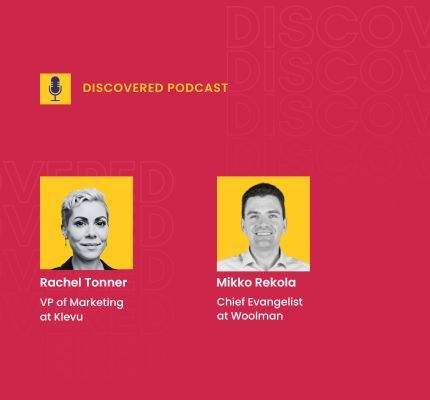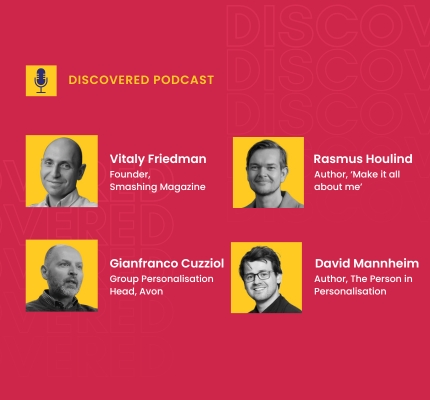
Podcast
Episode 10: Modern MACH Commerce: Compose & Conquer with Uniform, Klevu & Commerce Layer
Explore the future of e-commerce with insights from Commerce Layer, Klevu, and Uniform on composable commerce and digital transformation.
Podcast Description:
In this enlightening episode, Rachel Tonner hosts a vibrant discussion at the MACH House NRF with distinguished guests Filippo Conforti from Commerce Layer, Nilay Oza from Klevu, and Darren Guarnaccia from Uniform. This episode unveils the groundbreaking integration among these leaders in e-commerce technology, offering merchants a glimpse into the future of composable commerce. The conversation navigates through the essence and importance of composable commerce, addressing its critical role in meeting the growing demand for flexibility and personalization in the customer experience. The dialogue delves into the shopper’s perspective, highlighting the balance between speed and relevance facilitated by the advancements in MACH and composable commerce technologies. Furthermore, the discussion sheds light on the challenges and complexities inherent in transitioning to a MACH architecture and how each platform uniquely addresses these issues to simplify the digital commerce experience for both merchants and consumers.
This episode is a must-listen for e-commerce teams, digital innovators, and technology enthusiasts eager to understand the intricacies of composable commerce and how the synergistic integration of Klevu, Commerce Layer, and Uniform can revolutionize the e-commerce landscape. Whether you’re grappling with the challenges of adopting composable commerce or seeking to enhance your customer experience through advanced personalization and flexibility, this episode offers invaluable insights and practical advice from the forefront of e-commerce technology.
Guest BIO:
Filippo Conforti, Founder and CEO at Commerce Layer – With over seven years at the helm, Filippo has steered Commerce Layer to be a key player in simplifying e-commerce for global brands, emphasizing the importance of composable commerce for a personalized and scalable customer experience. His expertise and vision in the field make him a pivotal figure in the evolving landscape of digital commerce.
Nilay Oza, Founder and CEO at Klevu – Nilay is an entrepreneur deeply immersed in the world of machine-learning software development. His driving force is to enact change through software-led innovation, underpinned by a relentless pursuit of continuous learning. With a keen focus on enhancing product discovery, Nilay’s leadership at Klevu reflects his dedication to leveraging technology to improve discovery and personalization in online shopping, making the customer journey more intuitive and fulfilling.
Darren Guarnaccia, President at Uniform – Darren is recognized for his expertise in leveraging market opportunities to spark exponential growth. With a rich background in transforming product strategy and management, Darren excels in forging impactful partnerships and fostering customer-centric solutions. His leadership has been instrumental in driving revenue growth and operational excellence across high-growth and established software firms, marked by significant achievements at companies like Hootsuite, Sitecore, and Crownpeak.
References:
Transcript:
[00:00:00] Rachel Tonner: Hello, and welcome to the MACH House at NRF. I’m here with Filippo Conforti from Commerce Layer, Nilay Oza from Klevu, and Darren Granarca from Uniform. My name is Rachel Tonner, and I’m also from Klevu. We have just launched an integration between our three platforms to benefit merchants and those interested in adopting composable commerce.
[00:00:23] Rachel Tonner: I’m going to ask Filippo the first question. Why should e-commerce teams consider composable commerce important?
[00:00:29] Filippo Conforti: Composable commerce is particularly crucial for brands when they face greater complexity and more sophisticated requirements, necessitating specialized tools for each aspect of the customer experience. This is why composable commerce is the answer to the need for flexibility and personalization in customer experience.
[00:00:52] Rachel Tonner: It seems like it could be quite complex. Nilay, from your perspective, why is composable commerce important?
[00:00:59] Nilay Oza: Thank you, Rachel, and I’m glad to be here. From the shopper’s perspective, we’re in an era where people value their time highly. They want fast solutions but also need them to be relevant. With the advancements in technology, particularly with MACH and composable commerce, we have a genuine opportunity to amalgamate these technologies seamlessly, simplifying the complexity for the shopper. This approach, considering the shopper experience and focusing on curation and personalization, seems very logical for adopting composable commerce with a modern outlook.
[00:01:45] Rachel Tonner: Darren, your thoughts?
[00:01:57] Darren Guarnaccia: To add to both points, the rapid pace of change is another factor. Just a year ago, chatGPT wasn’t a common topic. Who knows what the next year will bring? Composable commerce allows for the quick and straightforward assembly of new technologies, providing the agility Filippo mentioned. It’s about preparing for the unknown and having the flexibility to adapt, which is crucial as customer expectations continue to escalate rapidly. The key benefit is being able to integrate new tools or replace ones that aren’t working, as opposed to being tied to a monolithic, one-size-fits-all platform.
[00:03:01] Rachel Tonner: You’ve all touched on the idea of composable commerce, but we’re aware there are challenges and pain points with moving to a MACH architecture. What are some of these challenges you’ve encountered?
[00:03:16] Rachel Tonner: Maybe we’ll start with you again, Filippo.
[00:03:18] Filippo Conforti: The primary challenge is often about the mindset shift from a single solution to a composite of solutions, which can seem daunting. Our role in the ecosystem is to help users understand that this complexity is manageable and something we can assist with, so it shouldn’t be intimidating or a source of fear.
[00:04:08] Rachel Tonner: Nilay, your insights on the pain points?
[00:04:11] Nilay Oza: It’s a great question. The first point would be the fear of the unknown from the retailer’s perspective. As a retailer making a significant investment in technology, whether it’s MACH or something else, there’s always the concern of what comes next. How will the different applications work together? This uncertainty can lead to hesitation. Although many integrations are successful, changes in one component can affect others, raising concerns about time, money, and effort. In the current economic climate, more retailers are looking to minimize these risks.
[00:05:42] Rachel Tonner: So, Filippo and Nilay, you both mentioned the importance of peace of mind, ensuring complexity is managed. How does Uniform address this concern, making it easier for both the back-end workers and shoppers?
[00:06:06] Darren Guarnaccia: A significant concern we hear from customers, especially retailers, is about being able to carry out necessary tasks. The shift to MACH has led to a heavy reliance on developers for changes that used to be more straightforward. Uniform was founded to bring back the autonomy for marketers, merchandisers, and content creators, allowing them to visually construct what they need. This empowerment is crucial for rapid experimentation and learning, enhancing the ability to respond quickly to what works and what doesn’t.
[00:07:21] Rachel Tonner: Filippo, in your newsletter, you often mention that commerce should be simple, involving just a commerce engine, search, and a CMS. Could you elaborate on how this simplicity addresses some of the pain points in MACH commerce?
[00:07:36] Filippo Conforti: I wouldn’t necessarily say it’s simple across the board, but at Commerce Layer, we aim to simplify what has traditionally been complex. The goal is to improve the developer experience in dealing with commerce, which can be inherently complex, especially for global brands with diverse needs. Our approach is about managing this complexity behind the scenes, ensuring the interface and experience are as straightforward as possible for the customer.
[00:08:47] Rachel Tonner: Nilay, finding something on a website should be straightforward. How does Klevu simplify this process for both merchandisers and shoppers?
[00:08:59] Nilay Oza: Search is a fundamental aspect of life; we’re always looking for something. When shoppers visit an online store, they have a clear intent, not there to browse but to find something specific. Klevu has been focused on understanding this intent and delivering the most relevant results, ensuring a genuine discovery experience. It’s about striking the right balance between AI-driven relevance and allowing retailers to have a degree of control over the search outcomes.
[00:11:03] Rachel Tonner: Darren, how does the integration with Uniform enhance the overall shopper experience, taking into account AI personalization and other factors?
[00:11:25] Darren Guarnaccia: Uniform plays a role in synthesizing various signals, from customer intent to behavioral analysis, ensuring that not just search results but the entire shopping experience is personalized. It’s about coordinating these insights to present the most relevant content, offers, and calls to action, making sure we recognize and respect the customer’s history and current needs.
[00:13:43] Rachel Tonner: Filippo, looking ahead, what are your predictions for the future of MACH commerce?
[00:13:57] Filippo Conforti: I anticipate a move towards simplification for the end-user and increased specialization within the ecosystem. The ability to select and potentially replace specialized tools as the market and technology evolve will be crucial.
[00:14:49] Nilay Oza: Building on Filippo’s point, I expect the perceived complexity of MACH commerce to diminish as it becomes more ingrained and intuitive, much like the progression suggested by Moore’s law.
[00:17:22] Rachel Tonner: Darren, can you differentiate between traditional MACH and a more modern approach, and how does our collaboration fit into this?
[00:17:28] Darren Guarnaccia: The traditional approach often involved coding everything, which led to decreased agility over time. The modern MACH approach is more about configuring rather than coding, emphasizing modularity and ease of integration, aligning with the need for agility and the ability to adapt to new trends and technologies.
[00:19:56] Rachel Tonner: For merchants looking to venture into MACH commerce, what advice would you give?
[00:20:03] Filippo Conforti: Merchants should start by evaluating their current systems and consider separating different aspects of the customer experience, such as content and commerce. Starting with two main components allows for a more manageable transition.
[00:22:25] Nilay Oza: Adding to Filippo’s advice, it’s essential to have clear expectations and understand how each component fits into your overall strategy to avoid surprises during the transition.
[00:23:07] Darren Guarnaccia: It’s about assessing your risk tolerance and how you can segment the journey into manageable pieces. There are various ways to approach this, allowing for learning and adaptation without overwhelming risk.
[00:24:32] Rachel Tonner: Thank you, Darren, Nilay, and Filippo, for your insights today. For those interested in learning more about our integration, feel free to reach out to us on LinkedIn.
[00:24:44] Filippo Conforti: Thank you.

